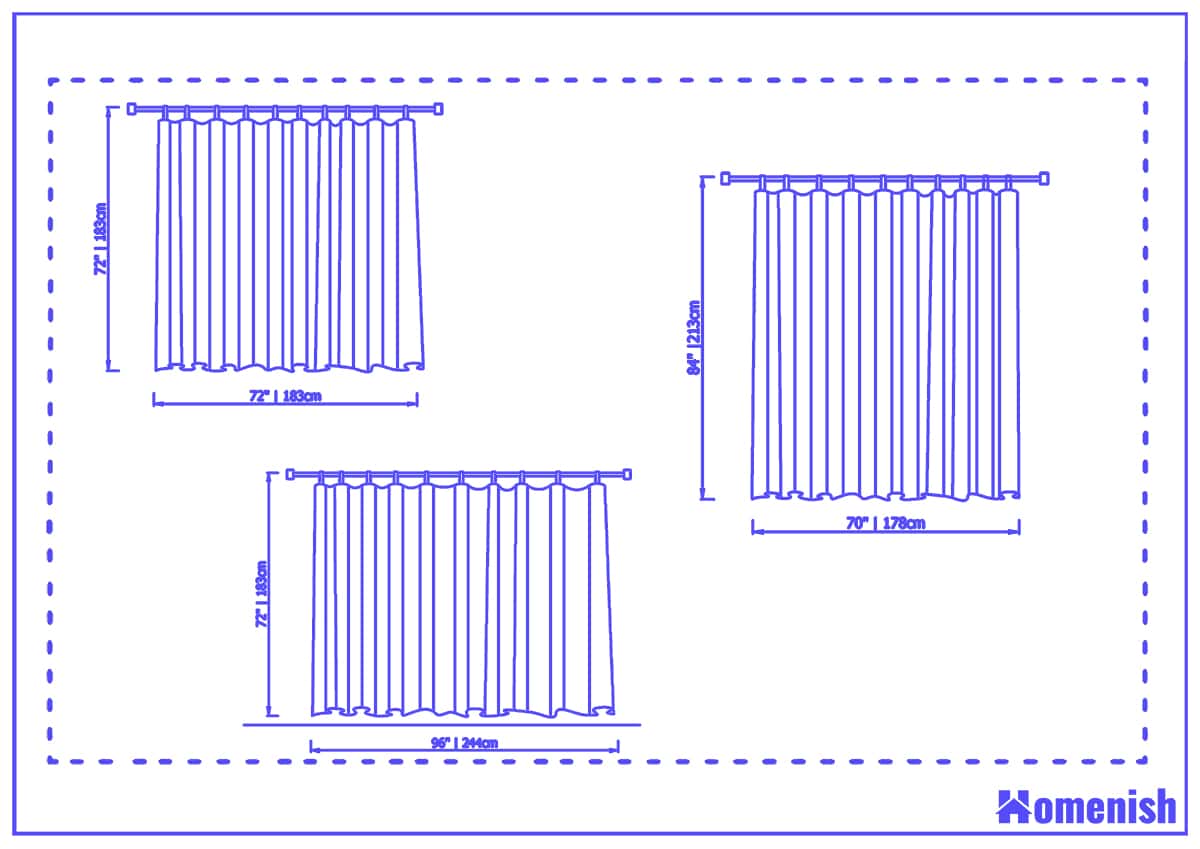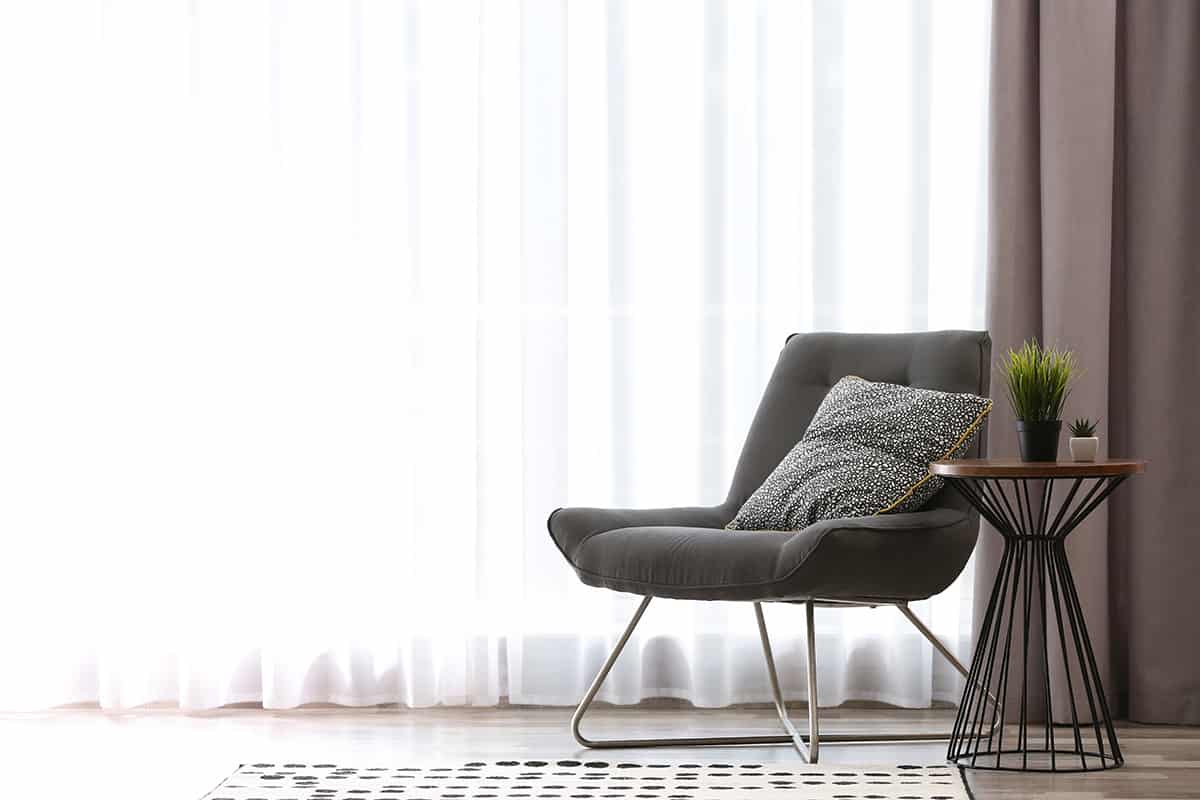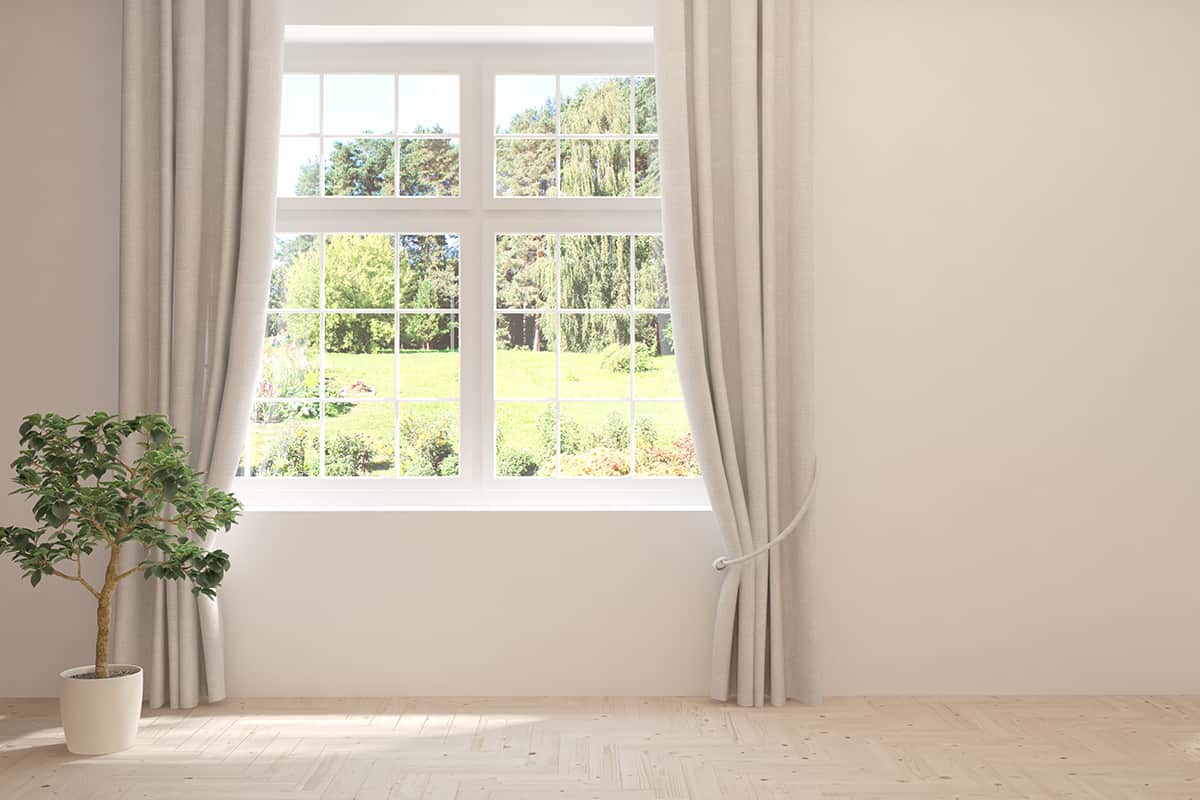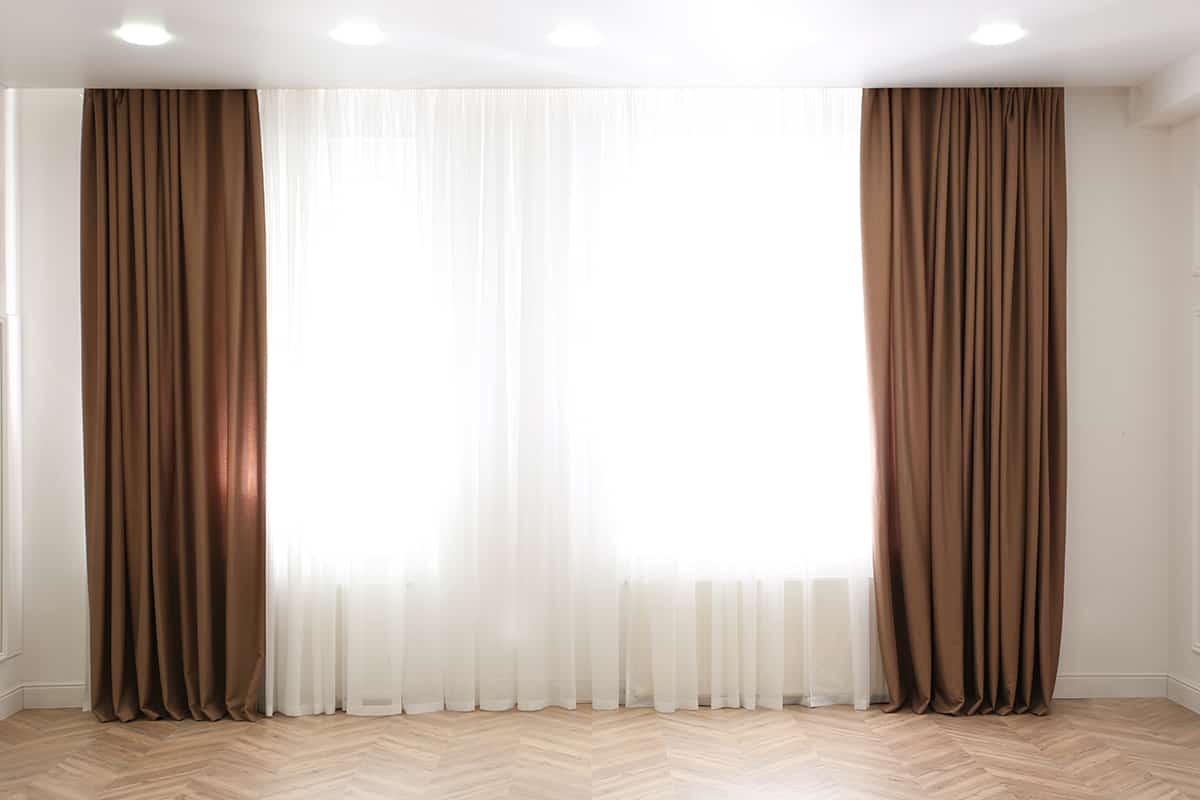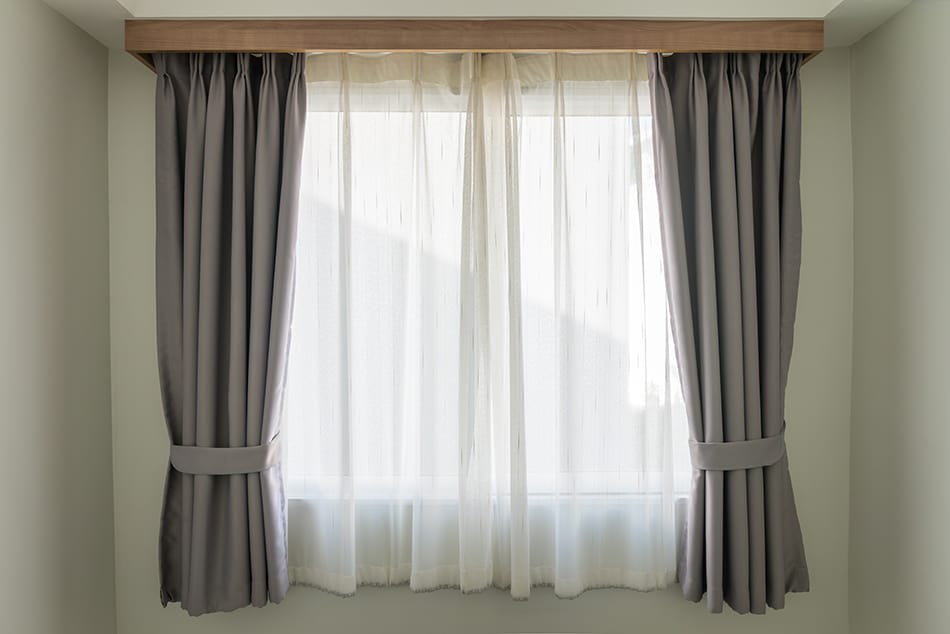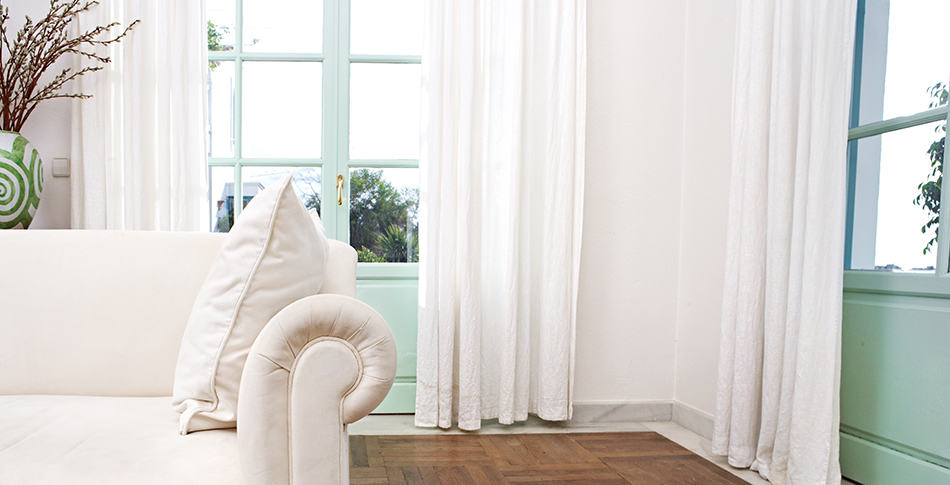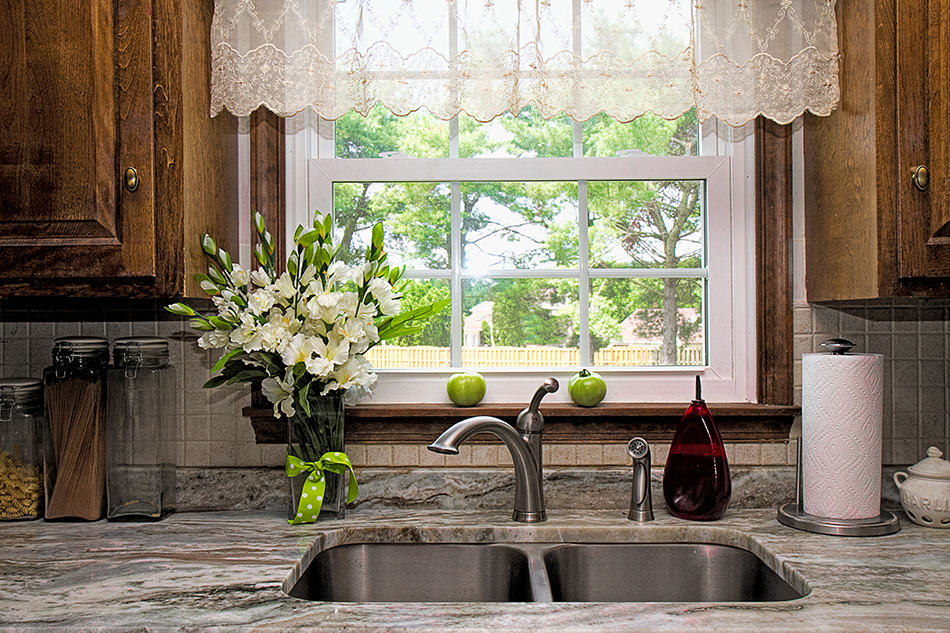Curtains come in a wide range of sizes to suit various types of windows and doors. If you have standard-sized windows, then you will be able to buy standard-size curtains to fit them perfectly, or in the case of non-standard windows, you could have curtains made to a custom size.
This comprehensive guide looks at different types of curtains and their standard dimensions and how to get the best size of curtains for your home.
- Standard curtain lengths are usually 63, 84, 96, 108, and 120 inches while the standard curtain width is 48 inches.
- For a good fit, add at least 6 inches over the window size and 24 inches to the width.
- Custom curtains are available but are more expensive and non-returnable.
Curtain Size Matters
It can be terribly tempting to quickly measure a window and order something just large enough to cover it. If you are strapped for time or dealing with a short-term rental, this can provide a quick solution to keep nosy neighbors away.
Nevertheless, choosing the right curtains can pay off immensely. Neat, well-lined, and carefully placed curtains will make a room look bigger and fresher. They can add to the room’s symmetry or help you hide an awkwardly placed window.
On the other hand, the effect of using the wrong curtain size is harder to define. Many times, it will be a matter of looking at a window and just feeling that something is off – whether the fabric is too tense or the rod too hard to reach.
If curtains are too short, you can also end up with a room that feels more like a college dorm than a proper home.
Standard Curtain Sizes
Custom-sized curtains are always a possibility – if you have a budget large enough, plus a few weeks before the move-in date, that is. However, in this day of online shopping, you can access thousands of gorgeous models and prints.
There is sure to be something out there that will match your dream room to perfection – and it is most likely available in five standard sizes.
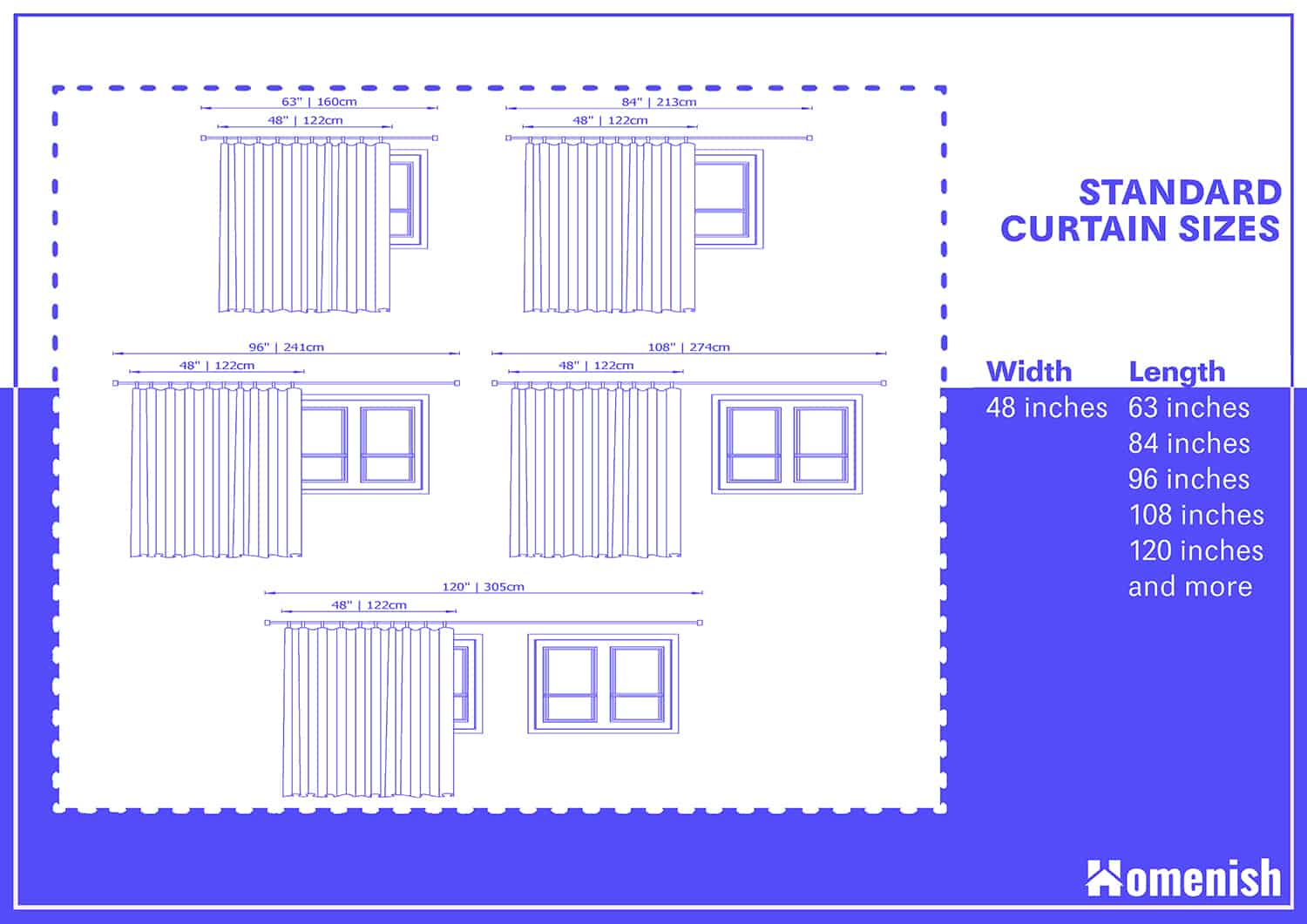
Standard Curtain Width
As a near-universal convention, most standard curtain panels are 48 inches wide, so sizes vary mostly in length. The idea is that if you have very wide windows, you should be able to line several curtains together – so the big challenge is to look for the right length.
Standard Curtain Length
Usually, curtains are available in the following lengths:
- 63 inches
- 84 inches
- 96 inches
- 108 inches
- 120 inches
The actual curtain size that you’ll need will be determined by the height of your ceiling and the desired effect. There is a lot of room to play around with here, and there is only one rule of thumb: do not, ever, buy curtains that are just the same length as the window. They simply won’t provide enough coverage.
Your ideal curtain size should always start at a bare minimum of 6 inches over the size of the window. This will give you a good 4 inches of leeway above the curtain to fit the rod, plus at least a couple of extra inches below the window. The latter will make sure your privacy remains protected during a passing breeze.
Custom Size Curtains
Custom-size curtains are only necessary in unique cases since most homes have standard-size windows and standard-size ceiling heights and, therefore require standard-size curtains.
However, there will, of course, be occasions where custom-size curtains are necessary, for example, in a historic property with unusually high ceilings or in a modern home where you have had custom glass panels installed on an exterior wall.
Custom-size curtains are easy to purchase online, simply by inserting the size you need and having them specially made. The biggest drawback of custom curtains is that they will be considerably more expensive than standard-size curtains.
With custom curtains, there is also the risk that you have measured incorrectly, and when the curtains arrive, they won’t fit as you had hoped. As with all custom and personalized items, you won’t be able to return them to the store for a refund because they have been custom-made to your requirements and therefore won’t be suitable to be sold to other customers.
How to Measure for Curtains
If this is the first time you are ordering curtains, you might be surprised by the number of different sizes available. Before you commit to a purchase, you first need to take the measurements of your window and the measurements of the window in relation to the floor and ceiling.
This will ensure you get curtains that are going to fit nicely into your space and function on both a practical level and a style level.
Window width
To find out the size of curtains you need, you first need to measure the width of your window. Take a tape measure and measure from the point where your window joins your wall on one side to where the window joins the wall on the opposite side.
Now add 24 inches to your measurement to give you the total width size of the curtains you need. 24 inches is added to account for the amount of fabric that will need to overhang at either side of the window.
For example, if your window measurement was 60 inches, you need to add 24 inches to give you a total of 84 inches. 84 inches is the minimum width of the curtain you should buy. Ideally, the size of the curtain width you buy should be 1.5 or 2 times the width of your window, as this will ensure the curtains look full when they are open.
If you are torn between two width sizes for your curtains, always opt for the larger set. It is much better to have curtains that are too wide rather than curtains that do not meet in the middle when you close them.
Drop length
The drop length is the more tricky measurement of the two, and it may take a few attempts to figure out the best curtain length for your room. First, you need to decide on the look you want from your curtains. Some people like the curtains to just meet the floor, while some people prefer the luxurious look of curtains elegantly trailing along the floor. In some instances, you may want shorter curtains that drop to just below the windowsill.
Once you have decided on the type of look you want from the length of your curtains, you can start measuring. First, measure between 4 and 8 inches above the top of your window. This is where you should position your curtain rod.
Make a mark on the wall, or if you already have a curtain pole fixed in place, then you can use that instead. Measure straight down from your curtain rod or the mark on the wall to the point where you want your curtains to reach.
This might be the floor, or it might be just below the windowsill. If you want your curtains to drape along the floor, add an additional 2 inches to your length measurement. The final measurement is the length of the curtains you need to order.
If the exact length isn’t available as standard, you could adjust the position of your curtain rod so that it hangs the curtains at a more suitable length, or you could have curtains custom-made to your measurements.
Curtain Panel Styles – How Low Do You Want to Go?
The way that you want your curtains to hang all comes down to personal preference. Most interior designers agree that curtains should either kiss the floor or drape gently against the floor. Curtains that fall a few inches above floor level can look awkward, so this is not recommended.
However, these can work best from a practical point of view. Here, we look at the different looks you can achieve with differing curtain length styles.
Floating Curtains
The idea behind floating curtains is to leave some room between the bottom edge of the curtain and the floor. This style is great for scenic rooms with very wide or panoramic views: if matched with sheer or light curtains or with an additional layer of cascading or tied draperies, floating curtains create a very exotic visual effect.
The main reason that people choose floating curtains is that they work so well from a practical angle.
If you have pets in the house, notably cats and dogs, then you might find you get a lot of pet hair clinging to the fabric of curtains that touch the floor. If your curtains don’t touch the floor to sweep up fallen hair, then they will remain much cleaner.
They also work well in playrooms and children’s rooms for the same reason. To measure for floating curtains, take a measurement of the length from your curtain rod to 2 inches above floor level.
Floor Kissing Length
As their name indicates, floor-kissing curtains should be long enough to just kiss the floor right beneath them without mopping it or puddling on it. This is an ideal option for rooms with high ceilings or bedrooms requiring blackout curtains.
Overall, “kiss-length” curtains tend to look very neat and polished, especially on relatively narrow windows. They also tend to look better when hung from thick grommet-style rods.
However, they require very exact measurements. You may need to opt for custom-made curtains or at least buy a size bigger and then shorten them.
Puddling Length
Puddling-length curtains are usually left up to two or three inches below the floor. The idea here is to get the curtains to puddle on the floor. This style is usually showcased in very formal rooms, such as old-style dining rooms. The “puddles” tend to look better with heavier winter fabrics, and velvety finishes will add to their dramatic appeal.
Conversely, puddling-length curtains can be complicated to maintain and hard to keep clean. If you have children, they may not be worth the hassle. They should also not be used near French doors or in windows facing a garden or a dusty area: they are not easy to open, and they will trap dust and dirt beneath the puddle.
Special Lengths
There are certain windows in the house that don’t need or shouldn’t have full coverage. A classic example of this is kitchen curtains, where full coverage would end up trapping smells and grease. However, this may also include very high windowsills and bathroom windows, if you have any.
There are three types of special lengths to consider here:
Tier curtains
These usually cover only the bottom half or two-thirds of a window, so they leave a slit that is never covered or darkened. These usually come in lengths of 34 or 36 inches.
These are very short curtains meant to cover only the top part of a window. They are often used in cottage-style décor or to provide some coverage for doors or bay windows. Standard-sized valances are usually 5 inches long.
Valance curtains
These are very short curtains meant to cover only the top part of a window. They are often used in cottage-style décor or to provide some coverage for doors or bay windows. Standard-sized valances are usually 5 inches long.
Windowsill curtains
Meant to end right at the windowsill, these curtains are often used in kitchens or when there is a big piece of furniture right beneath.
Tips on Choosing the Right Curtain Size
If you’re starting from scratch, plan where to hang your curtains and their length.
Before choosing a size, pinpoint where the rods will go. Place them at least 4 inches above the window to hide the rod and ensure coverage.
For added insulation, position the rod 2 inches below the ceiling and opt for thick or blackout fabric.
Ensure each rod has at least three support points to attach itself to the wall. Add an extra point for blackout curtains to boost stability.
When deciding on the total width (or the number of panels you will be lining up for each window) of your curtains, make sure you have enough fabric left to flare them up a bit. Ideally, the total width should be 1.5 to 2 times the width of the actual window. Ensure rods start 3 inches from window edges for ease of use.
And finally, consider nearby furniture when choosing curtain length. For long curtains, adjust furniture. If unsure of size, go larger—it’s easier to trim than extend.
Ready to Get Started?
Before shopping for curtains, you will need to decide on the right length. Well-planned curtains will make your room look tidier and bigger. Make sure to grab a step ladder and some measuring tape to get a precise location for your curtain rods. Then, use the length of the rods as a reference.
